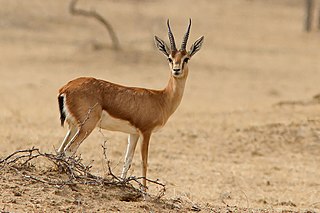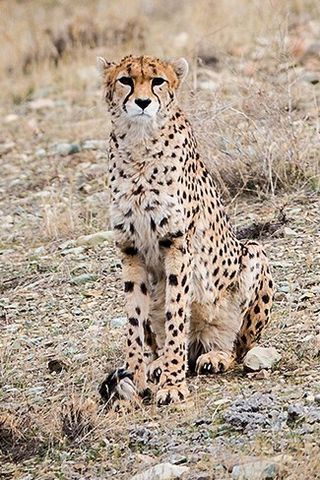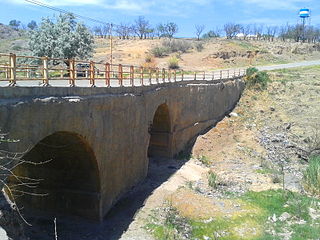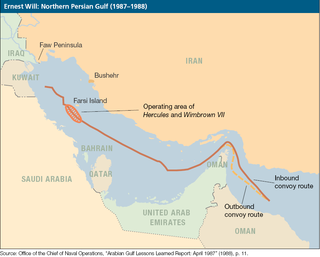
A nature reserve is a protected area of importance for flora, fauna, funga, or features of geological or other special interest, which is reserved and managed for purposes of conservation and to provide special opportunities for study or research. They may be designated by government institutions in some countries, or by private landowners, such as charities and research institutions. Nature reserves fall into different IUCN categories depending on the level of protection afforded by local laws. Normally it is more strictly protected than a nature park. Various jurisdictions may use other terminology, such as ecological protection area or private protected area in legislation and in official titles of the reserves.

Operation Praying Mantis was the 18 April 1988 attack by the United States on Iranian naval targets in the Persian Gulf in retaliation for the mining of a U.S. warship four days earlier.

Dasht-e Kavir or the Kavir Desert, also known as Kavir-e Namak or the Great Salt Desert, is a large desert lying in the middle of the Iranian Plateau. It is about 800 kilometres (500 mi) long by 320 kilometres (200 mi) wide with a total surface area of about 77,600 km2 (30,000 sq mi), making it the world's 24th largest desert. The desert stretches from the Alborz mountain range in the north-west to the Dasht-e Lut in the south-east. It is spread across the Iranian provinces of Khorasan, Semnan, Tehran, Isfahan and Yazd.

The chinkara, also known as the Indian gazelle, is a gazelle species native to India, Iran, Afghanistan and Pakistan.

Tandooreh National Park is a protected area located in the northeast of Iran, near the city of Dargaz and the Turkmenistan border. The mountainous area features deep valleys and cliffs, with Juniper woodlands on the slopes, and wooded thickets along the rivers in the valleys. Open areas are typically Artemisia steppe. Elevations range from 980–2,600 metres (3,220–8,530 ft).

The Asiatic cheetah is a critically endangered cheetah subspecies currently only surviving in Iran. Its range once spread from the Arabian Peninsula and the Near East to the Caspian region, Transcaucasus, Kyzylkum Desert and northern South Asia, but was extirpated in these regions during the 20th century. The Asiatic cheetah diverged from the cheetah population in Africa between 32,000 and 67,000 years ago.

Panthera pardus tulliana, also called Persian leopard,Anatolian leopard, and Caucasian leopard in different parts of its range, is a leopard subspecies that was first described in 1856 based on a zoological specimen found in western Anatolia. It is native to the Iranian Plateau and the surrounding region from eastern Anatolia and the Caucasus to the Hindu Kush, where it inhabits foremost subalpine meadows, temperate broadleaf and mixed forests and rugged ravines at elevations of 600 to 3,800 m. It preys mostly on ungulates reliant on these habitats.
The Iranian ground jay or Pleske's ground jay, is a species of bird in the family Corvidae. It is endemic to Iran where it is known as Zaghbur in Persian.

The Hyrcanian forests are a zone of lush lowland and montane forests covering about 55,000 square kilometres (21,000 sq mi) near the shores of the Caspian Sea in Iran and Azerbaijan. The forest is named after the ancient region of Hyrcania. The World Wide Fund for Nature refers to the ecoregion as the Caspian Hyrcanian mixed forests. Since 5 July 2019, the Hyrcanian Forests have been designated a UNESCO World Heritage Site. In September 2023, the heritage site expanded to incorporate portions of the forest located in Azerbaijan.

Gori Lake is a small fresh to brackish lake in the uplands of East Azarbaijan Province in north-western Iran. Together with the adjacent reed marshes it is an important breeding area for waterfowl. A 1.2 km² site was designated as a Ramsar Convention wetland protection site on 23 June 1975.
Arzhan District is in Shiraz County, Fars province, Iran. Its capital is the city of Khaneh Zenyan.
The Iranian Department of Environment is a governmental organization, under the supervision of the president, that is responsible for matters related to safeguarding the environment.

Varzaneh is a village in Dastjerd Rural District, Khalajestan District, Qom County, Qom Province, Iran. At the 2006 census, its population was 158, in 46 families. Approximately a hundred kilometers away from Isfahan and two hundred from Yazd, Varzaneh (ورزنه) is known for its wonderful sand dunes. The place is frequented by tourists who are seeking the peace of a night spent in a desert and the warmth of an evening around a campfire sitting with Iranians on a Persian carpet under the stars.

Lar National Park is a protected area in Amol County of Mazandaran Province in northern Iran.
Jahan Nama is a village in Chaharkuh Rural District, in the Central District of Kordkuy County, Golestan Province, Iran. At the 2006 census, its population was 99, in 43 families. This area is situated in the southern heights of Gorgan and the southeast of Kord Kooy. In 1973, it was claimed as a protected place with 30,650 hectares in area. This region was a recreational area for people of Gorgan and its nearby villages. Some important regions like Torkat, Chalestan, Cholqoleh, Aq Reza, Chakel Geda, Landeh Kooh, Talou, Khoshdasti, Landou and Maqzi, are around this protected area.
The Geno Biosphere Reserve, with a total area of 27,500 hectares, situated in the Hormozgan province of Iran. It has been designated as a protected area by the Iranian Department of Environment in 1976.

The Mond River, also known in English as the Mand River, runs through Fars Province and Bushehr Province in south-western Iran, flowing to the Persian Gulf.

The Bridgeton incident was the mining of the supertanker SS Bridgeton by Iranian IRGC navy near Farsi Island in the Persian Gulf on July 24, 1987. The ship was sailing in the first convoy of Operation Earnest Will, the U.S. response to Kuwaiti requests to protect its tankers from attack amid the Iran–Iraq War.

The International Maritime Security Construct (IMSC) is a consortium of countries whose official stated aim is the maintenance of order and security in the Persian Gulf, Strait of Hormuz, Gulf of Oman, Gulf of Aden, Bab-el-Mandeb, and Southern Red Sea, particularly regarding maritime security of global oil supply routes. It was formed on 16 September 2019 in Bahrain, by the United Kingdom, Australia, Albania, Saudi Arabia, Bahrain, Lithuania, the United Arab Emirates, and the United States. The operational arm of the IMSC is Coalition Task Force SENTINEL.













